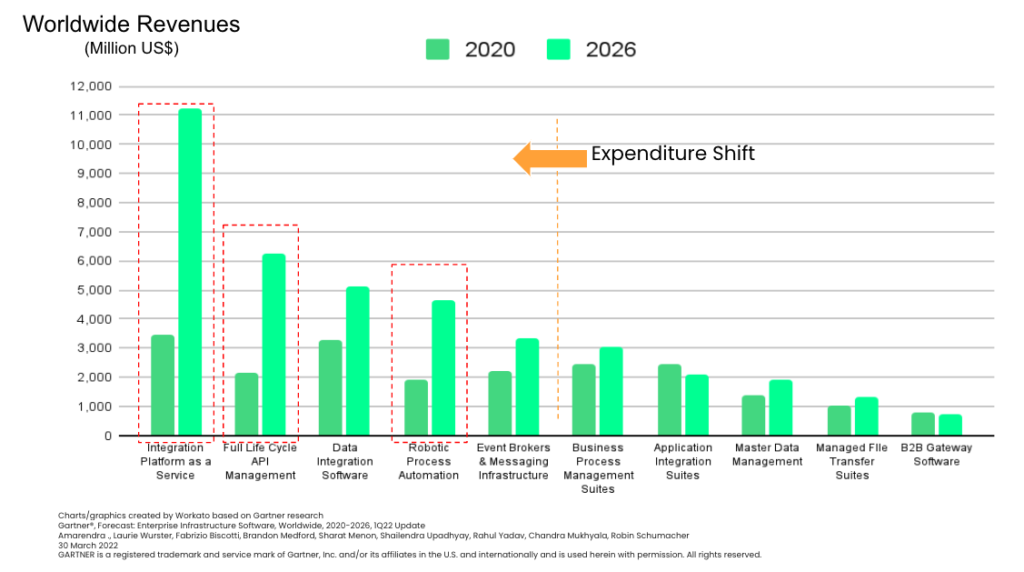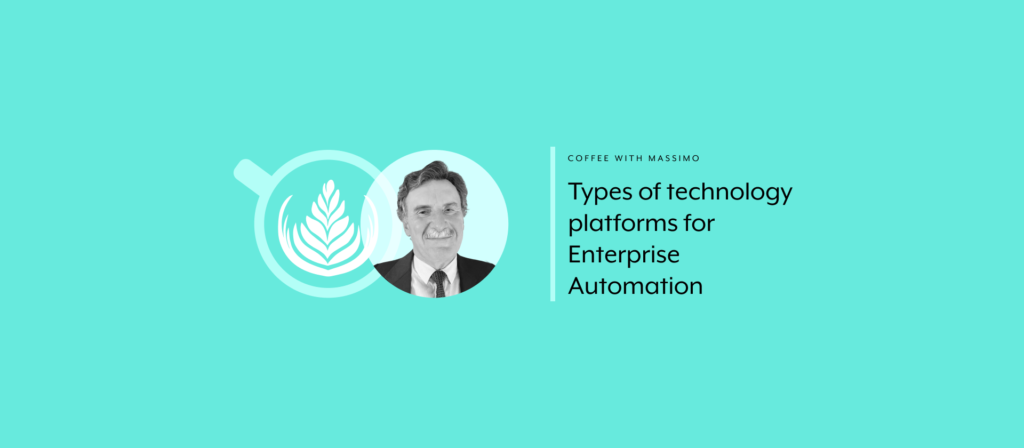A comprehensive enterprise automation platform delivers a multitude of capabilities—from application and data integration to process automation to API publishing to IoT integration.
Unlocking this broad functionality, however, likely requires you to adopt more than one type of technology.
So, out of the 10 types of technology platforms you can leverage as part of your enterprise automation strategy, which should you use?
While there’s no answer that’s one-size-fits-all, the current and predicted spending in the integration and automation market point to a few technology platforms that IT buyers are primarily interested in: iPaaS, RPA, and full lifecycle API management.

We’ll cover each type of technology in depth so you can determine whether they make sense for your enterprise automation platform.

Want to learn more?
These insights were presented during one of our “Coffee with Massimo” monthly webinars. You can watch the session’s full recording to catch everything Massimo shared!
Robotic process automation (RPA)
Simply put, robotic process automation emulates human tasks at the UI level (that is, by “screen scraping” the UI itself) through the use of software scripts, otherwise referred to as “bots.”
Some RPA tools are delivered in the cloud, while others are provided as on-premises software. And, depending on the vendor you select, you may take advantage of additional features, like intelligent document processing, process mining, and a control dashboard.
RPA is typically used to automate repetitive tasks that change infrequently (e.g. inputting invoice data into your ERP system), allowing your team to save time and avoid costly human errors. That said, since RPA isn’t designed to handle complex workflows, in principle, it shouldn’t be treated as the centerpiece of your process automation strategy. There are many potential automation use cases that can be better supported by other tools, such as BPM, low-code application development platforms, or—as we’ll soon cover—iPaaS.
Related: What is business process integration?
API management platform
API management allows you to control the full lifecycle of your APIs, with the overarching goal of providing governance and lifecycle management that facilitates secure, reliable, and efficient access to the application logic and data that you have exposed via APIs.
To help spur awareness and adoption of your APIs, the platform allows you to publish them in a developer portal. There, developers can find and learn about the functionality and technical implementation of each API. In addition, an API management platform helps you track adoption, usage patterns, and it enables you to manage runtime performance and scalability via approaches like throttling and caching.
Although API management platforms provide some elementary integration capabilities (for example, protocol bridging and API payload transformation), its primary role is to facilitate, manage, and control access to API-based applications and data services. Therefore, they should be treated as complementary to integration and automation platforms, such as iPaaS, ESBs or RPA.
Related: The pros and cons of RPA and workflow automation
Integration platform as a service (iPaaS)
You can think of an iPaaS as the swiss army knife for your enterprise automation platform strategy.
It allows you to implement integration flows that span applications, data, and processes; moreover, many now also offer API management and event brokering functionality.
On top of its versatile capabilities, a modern iPaaS like Workato offers a low-code/no-code UX. This makes it easier for a range of personas, including citizen integrators, to implement integrations and automations themselves—versus having to rely on the availability of integration specialists in IT.
The modern iPaaS’ ease of use, coupled with its range of enterprise-class capabilities, make it well suited to support a significant share of your enterprise automation platform’s requirements. This is especially true if your organization is a midsize or small business, as an iPaaS can likely fulfill most of—if not all of—your enterprise automation platform’s needs. If your organization is on the larger side, it should still complement your incumbent solutions and get used in scenarios that suit it well, such as cloud-centric integration projects or use cases where time to value is paramount. Moreover, as you look to scale your integrations, but have a limited number of integration developers available, iPaaS’ short learning curve and high developer productivity make it a very suitable approach.
Now it’s your turn: You may already have one of these platforms in place and, quite possibly, some from previous generations (for example, an ESB or a managed file transfer platform). Take a moment to reflect on your enterprise automation environment, and see if you can pinpoint the platform (or the combination of platforms) that can best help you address your organization’s requirements.
